 Facebook
Facebook
 X
X
 Instagram
Instagram
 TikTok
TikTok
 Youtube
Youtube
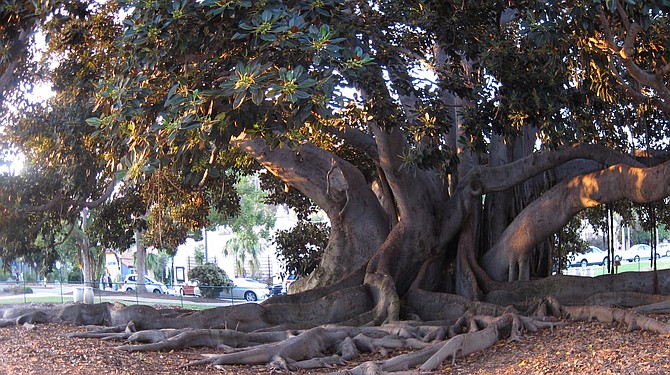
Trees were a hot topic at last week's (July 6) Balboa Park committee meeting. There was talk of planting new trees (500 over the next two years), inventorying all trees (1200 done so far), and how to "become one" with the mammoth Moreton Bay Fig.

Balboa Park has hundreds of different tree species, including rarities like palms grown from seeds found in the tombs of Egyptian Pharaohs. But no tree looms as large as the iconic Moreton Bay fig (ficus macrophylla). Hailing from Australia, the tree was planted where it now stands before the 1915 Panama-California Exposition. What started off as a modest five-gallon tree has grown into the biggest tree in Balboa Park, and one of the largest of its kind in the nation.

The outdated sign in front of the century-old tree states measurements of more than 80 feet tall with a canopy width of 145 feet and a trunk girth of 42 feet. This type of tree can live to be more than 150 years and grow as tall as 180 feet and 130 feet wide. There are maybe three more Moreton Bay figs of this size in California.
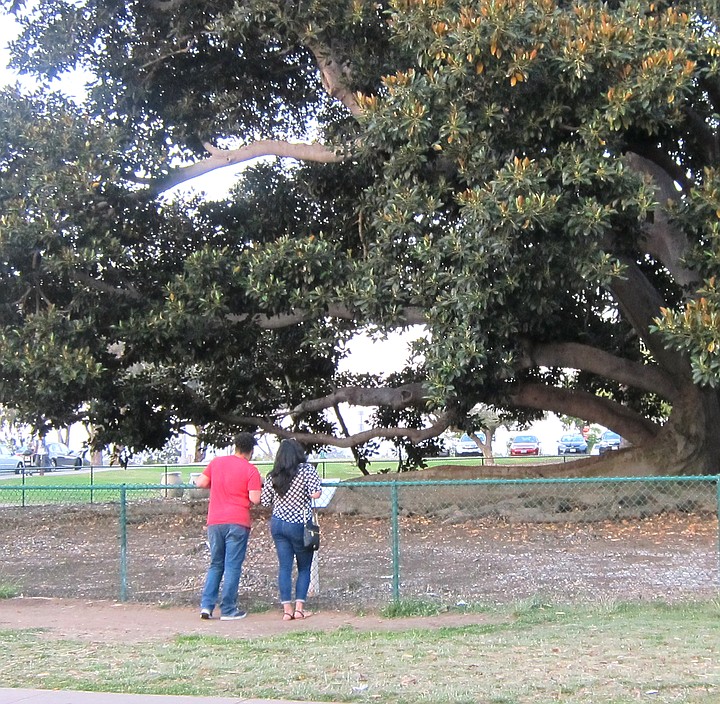
The Moreton Bay fig sits next to the Natural History Museum. During the 1915 exposition, the county's exhibition building was where the museum is now. Nearby the newly planted Moreton Bay fig was a citrus orchard and a formal garden featuring thousands of plants meant to show the world that anything can grow in Southern California. The Moreton Bay fig is all that remains today from the county's 1915 exhibition orchard and garden.
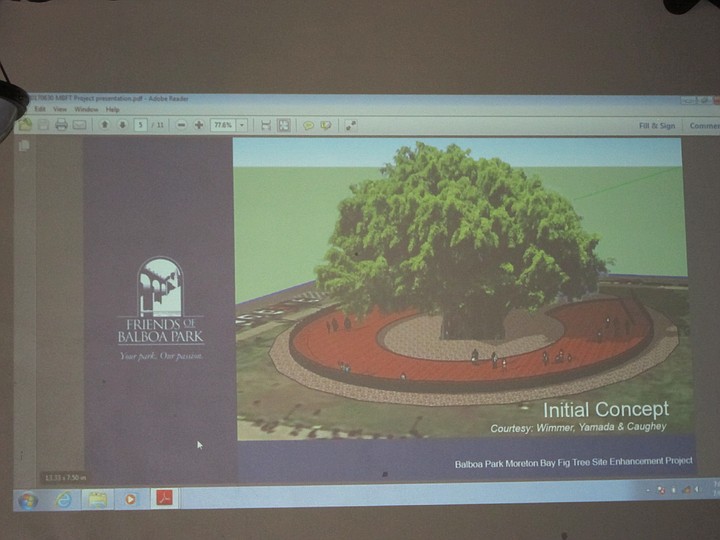
The county's exhibition building burned to the ground in 1925 as firefighters planned to attend their annual ball there that night. In the 1930s, the Natural History Society built the Natural History Museum in its place.
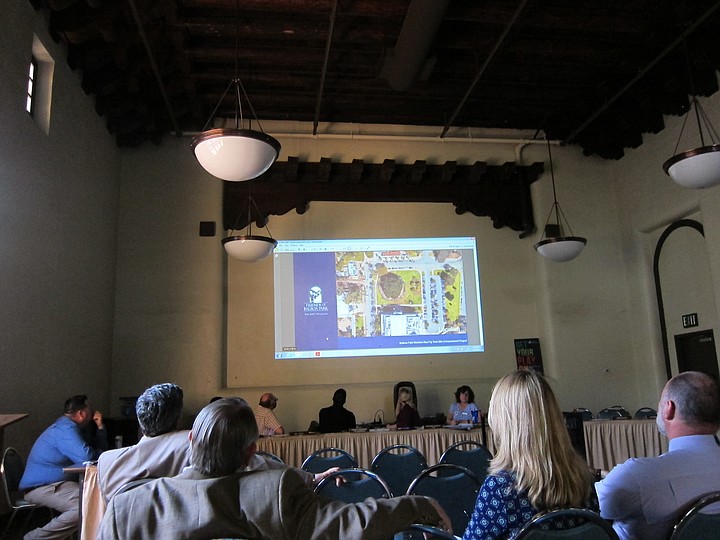
At the committee hearing on July 6, John Bolthouse and Pat Caughey of Friends of Balboa Park introduced conceptual drawings for a proposed viewing platform for the iconic tree. The non-profit Friends of Balboa Park was formed in 1999 to help preserve our crown jewel. One of their largest undertakings to date is their recent purchase of the historic Balboa Park Carousel.
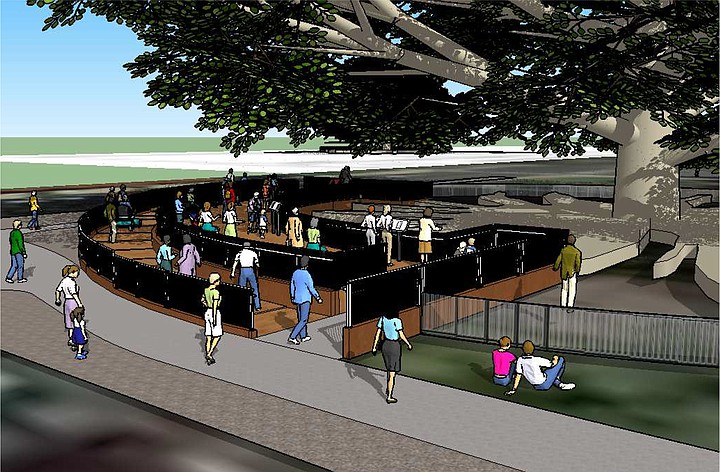
The Moreton Bay fig viewing platform would open the door to removing the fencing that surrounds the tree. The fencing went up in 1989 to protect the tree from climbing children and foot traffic on the tree's surface-feeding roots — both wreaking havoc on the tree.
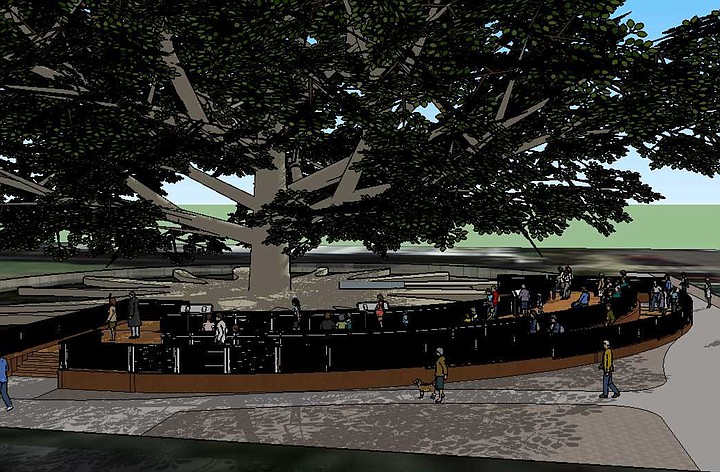
San Diego native Monica Schott remembers the tree as a magical place. As a kid in the 1980s, she climbed the tree when she spent summers with her grandmother on Cortez Hill. "We had this little ritual. We would walk down to Woolworth's [now House of Blues] and pick up yarn so she could knit, and popcorn and an Icee for me. Once at the park, she'd sit on the blanket and just watch me and the other kids climb the tree. My favorite branch - yes I had a favorite branch - was the lowest branch closest to the Natural History Museum. I would actually sit on it and crawl all the way to the end."
Schott said she would hide in the tree's crevices and that they felt like caves to her. She loved walking across the roots with her arms extended out to keep her balance. "I'd walk on every single root and try not to touch the ground while making it all the way around." She said that everyone carved on the branches and if you could get close enough today, you would see "tons of carvings."
As an adult, Schott wanted to carry on the tradition by bringing her own daughter to the tree only to find it was fenced off. "I wanted her to experience the same magic I remembered. I wanted to have picnics with her and watch her balance on the roots like I once did."
Caughey said he climbed all over the tree as a child. "You know it's beautiful to look at from a distance, but it's even more amazing to look at up close."
Since 1989, the tree has bounced back, but Caughey, a landscape architect, explained it's still of paramount importance to keep the tree safe as people are allowed to get closer.
Caughey showed slides of conceptual drawings of a circular deck around part of the tree. He explained that it would be elevated between 18 to 24 inches above the ground so as not to disturb the root structure. The idea is that the deck structure would sit on top and the feet of the deck would be set between the roots that are now encroaching out across the lawn area. Materials used would be some sort of composite material like recycled bricks.
There would be benches around the perimeter and interpretative signage similar to what's found in the Natural History Museum. There would be a ramp for a viewing deck allowing people to get close under the tree. Providing insets for live entertainment (bands) was suggested to allow events to be held using the tree as a backdrop.
There would still be a need for some barrier fencing said Caughey. A cable rail system was suggested for around the base of the tree.
Bolthouse and Caughey stressed that everything is conceptual at this point and needs to wind its way through the approval process. Caughey said that people are already interested in donating funds for the project.
Committee member Johanna Schiavoni asked about one of the slides Caughey showed of the initial concept that had the platform going almost all the way around the tree. Caughey said it was too much and they wanted to make sure the focus was on the tree.
When asked about the possibility of installing lighting, Caughey said while it's possible, there's been nothing decided. He said the goal of the space is to make it what it's going to be all the time.
There may be more going on near the iconic tree soon than the proposed viewing platform. In a 2012 city document about the love-it-or-hate-it Plaza de Panama parking garage and Cabrillo Bridge bypass project, it mentions the parking lot adjacent to the Moreton Bay Fig. This parking lot built circa 1964 — where there used to be that beautiful 1915 county exhibition garden — will be reconfigured for the Plaza de Panama project. While the document states "the Moreton Bay Fig tree would be retained," the 2012 environmental impact report for the same project points to hundreds of other trees that will be relocated and removed.


Trees were a hot topic at last week's (July 6) Balboa Park committee meeting. There was talk of planting new trees (500 over the next two years), inventorying all trees (1200 done so far), and how to "become one" with the mammoth Moreton Bay Fig.

Balboa Park has hundreds of different tree species, including rarities like palms grown from seeds found in the tombs of Egyptian Pharaohs. But no tree looms as large as the iconic Moreton Bay fig (ficus macrophylla). Hailing from Australia, the tree was planted where it now stands before the 1915 Panama-California Exposition. What started off as a modest five-gallon tree has grown into the biggest tree in Balboa Park, and one of the largest of its kind in the nation.

The outdated sign in front of the century-old tree states measurements of more than 80 feet tall with a canopy width of 145 feet and a trunk girth of 42 feet. This type of tree can live to be more than 150 years and grow as tall as 180 feet and 130 feet wide. There are maybe three more Moreton Bay figs of this size in California.

The Moreton Bay fig sits next to the Natural History Museum. During the 1915 exposition, the county's exhibition building was where the museum is now. Nearby the newly planted Moreton Bay fig was a citrus orchard and a formal garden featuring thousands of plants meant to show the world that anything can grow in Southern California. The Moreton Bay fig is all that remains today from the county's 1915 exhibition orchard and garden.

The county's exhibition building burned to the ground in 1925 as firefighters planned to attend their annual ball there that night. In the 1930s, the Natural History Society built the Natural History Museum in its place.

At the committee hearing on July 6, John Bolthouse and Pat Caughey of Friends of Balboa Park introduced conceptual drawings for a proposed viewing platform for the iconic tree. The non-profit Friends of Balboa Park was formed in 1999 to help preserve our crown jewel. One of their largest undertakings to date is their recent purchase of the historic Balboa Park Carousel.

The Moreton Bay fig viewing platform would open the door to removing the fencing that surrounds the tree. The fencing went up in 1989 to protect the tree from climbing children and foot traffic on the tree's surface-feeding roots — both wreaking havoc on the tree.

San Diego native Monica Schott remembers the tree as a magical place. As a kid in the 1980s, she climbed the tree when she spent summers with her grandmother on Cortez Hill. "We had this little ritual. We would walk down to Woolworth's [now House of Blues] and pick up yarn so she could knit, and popcorn and an Icee for me. Once at the park, she'd sit on the blanket and just watch me and the other kids climb the tree. My favorite branch - yes I had a favorite branch - was the lowest branch closest to the Natural History Museum. I would actually sit on it and crawl all the way to the end."
Schott said she would hide in the tree's crevices and that they felt like caves to her. She loved walking across the roots with her arms extended out to keep her balance. "I'd walk on every single root and try not to touch the ground while making it all the way around." She said that everyone carved on the branches and if you could get close enough today, you would see "tons of carvings."
As an adult, Schott wanted to carry on the tradition by bringing her own daughter to the tree only to find it was fenced off. "I wanted her to experience the same magic I remembered. I wanted to have picnics with her and watch her balance on the roots like I once did."
Caughey said he climbed all over the tree as a child. "You know it's beautiful to look at from a distance, but it's even more amazing to look at up close."
Since 1989, the tree has bounced back, but Caughey, a landscape architect, explained it's still of paramount importance to keep the tree safe as people are allowed to get closer.
Caughey showed slides of conceptual drawings of a circular deck around part of the tree. He explained that it would be elevated between 18 to 24 inches above the ground so as not to disturb the root structure. The idea is that the deck structure would sit on top and the feet of the deck would be set between the roots that are now encroaching out across the lawn area. Materials used would be some sort of composite material like recycled bricks.
There would be benches around the perimeter and interpretative signage similar to what's found in the Natural History Museum. There would be a ramp for a viewing deck allowing people to get close under the tree. Providing insets for live entertainment (bands) was suggested to allow events to be held using the tree as a backdrop.
There would still be a need for some barrier fencing said Caughey. A cable rail system was suggested for around the base of the tree.
Bolthouse and Caughey stressed that everything is conceptual at this point and needs to wind its way through the approval process. Caughey said that people are already interested in donating funds for the project.
Committee member Johanna Schiavoni asked about one of the slides Caughey showed of the initial concept that had the platform going almost all the way around the tree. Caughey said it was too much and they wanted to make sure the focus was on the tree.
When asked about the possibility of installing lighting, Caughey said while it's possible, there's been nothing decided. He said the goal of the space is to make it what it's going to be all the time.
There may be more going on near the iconic tree soon than the proposed viewing platform. In a 2012 city document about the love-it-or-hate-it Plaza de Panama parking garage and Cabrillo Bridge bypass project, it mentions the parking lot adjacent to the Moreton Bay Fig. This parking lot built circa 1964 — where there used to be that beautiful 1915 county exhibition garden — will be reconfigured for the Plaza de Panama project. While the document states "the Moreton Bay Fig tree would be retained," the 2012 environmental impact report for the same project points to hundreds of other trees that will be relocated and removed.
Comments